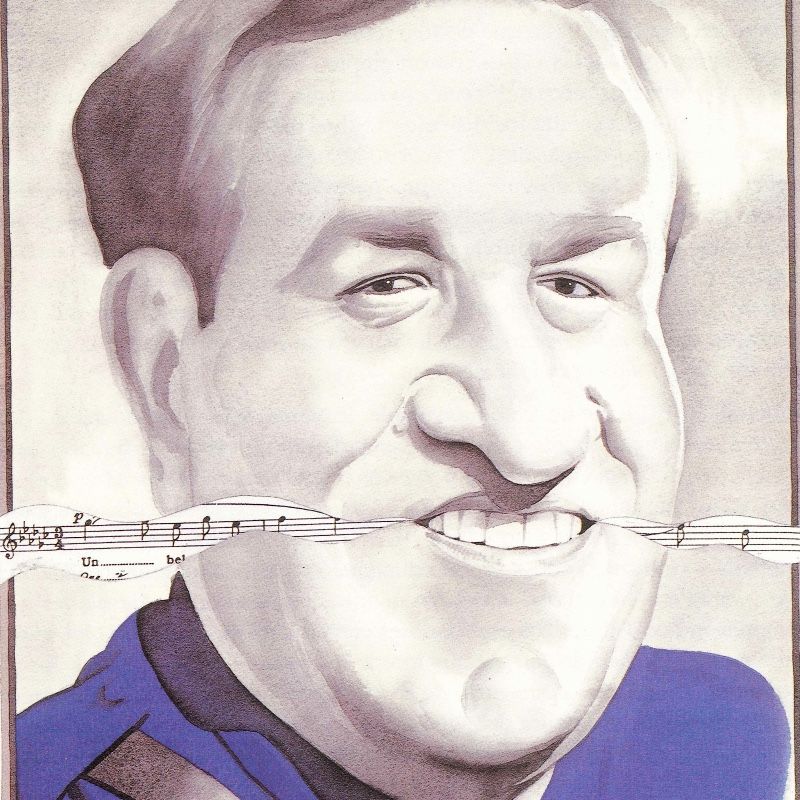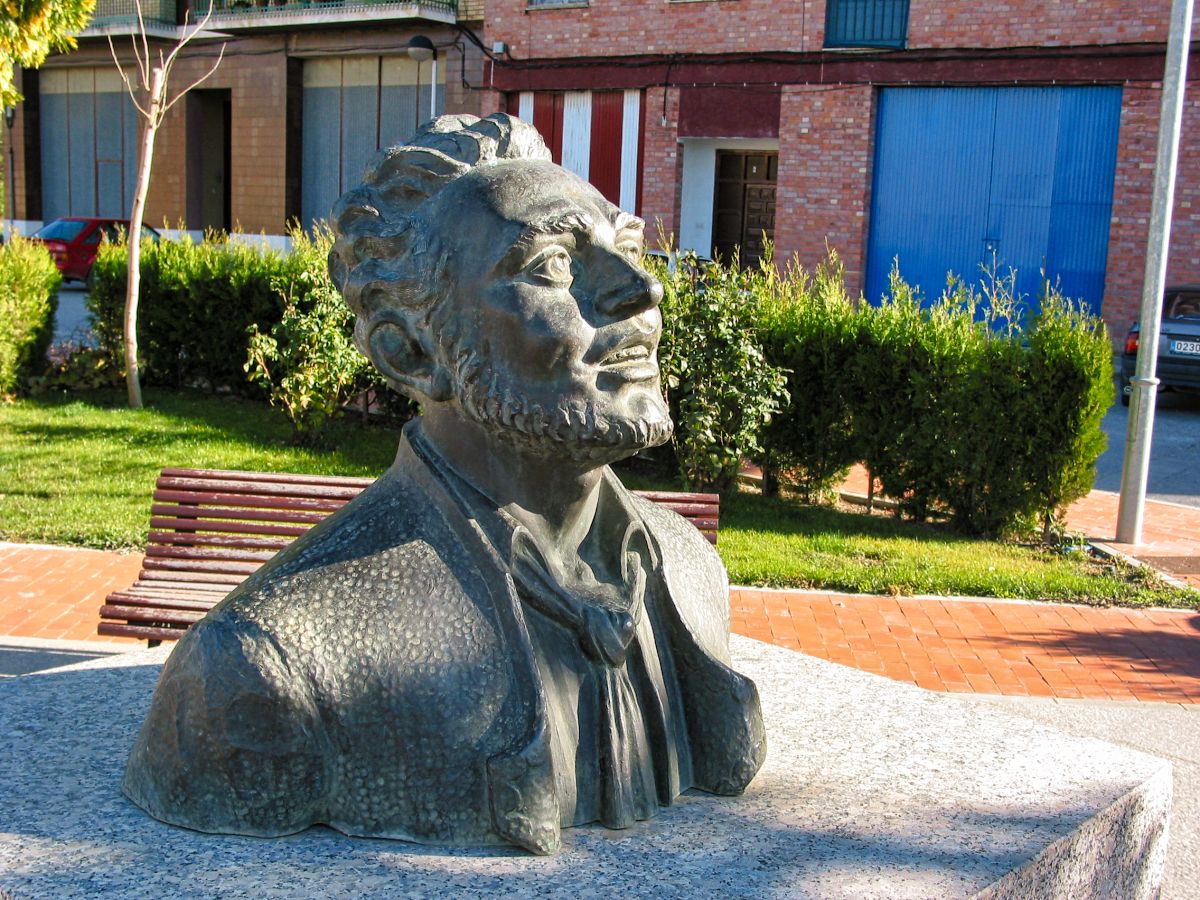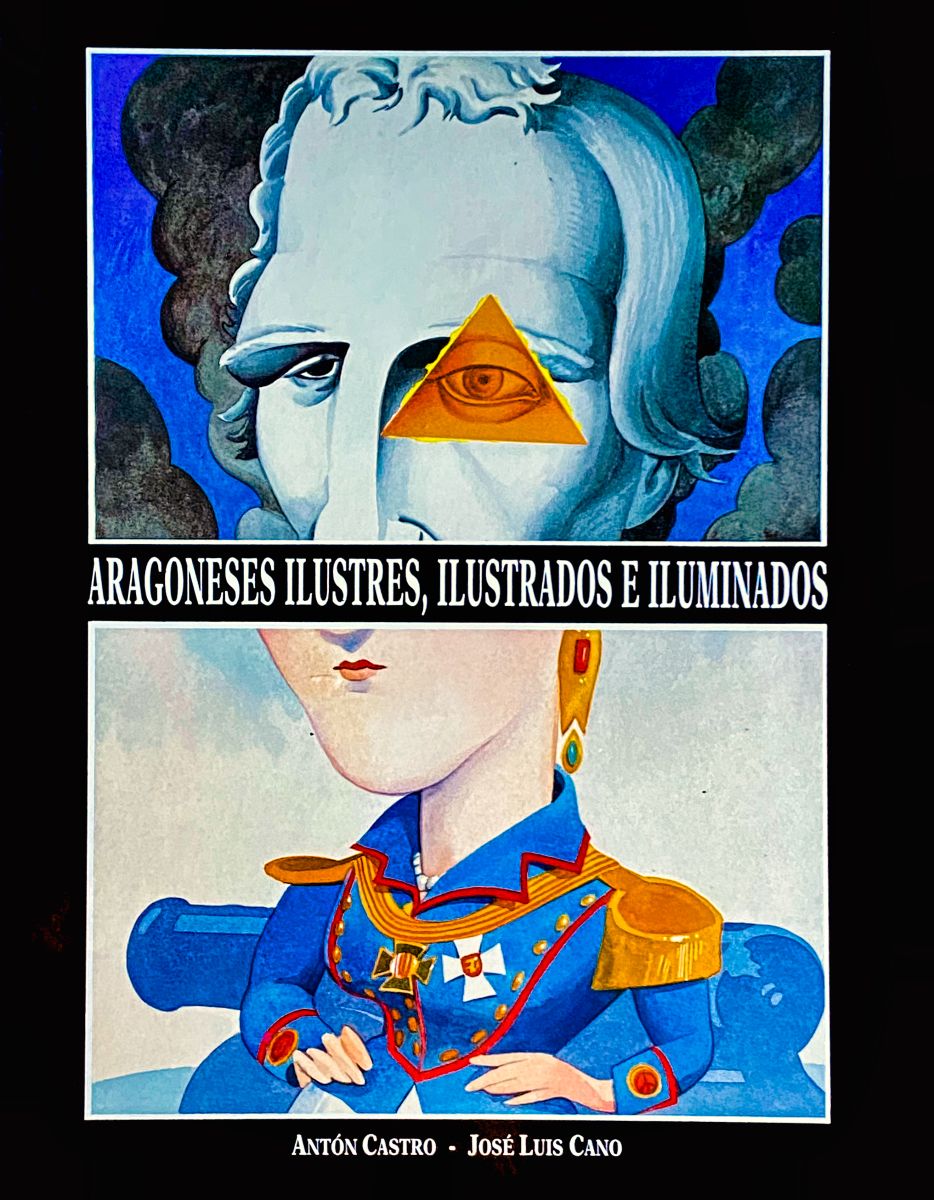Miguel Fleta
The voice, a prodigy of nature
Albalate de Cinca, 1897 – Coruña, 1938
The man who was to become the greatest tenor of his time, admired halfway around the world, was born Miguel Burro Fleta, the son of Vicente and María, into a humble family of farmers. The youngest of many siblings, from an early age, without going to school, he had to work as a shepherd, in agricultural work and, later, as a labourer on the Aragon and Catalonia canal works and carrying fruit and vegetables in Saragossa. His grandfather and his father had a special inclination and facility for music. Vicente Burro played several instruments (he apparently showed off in a modest café he ran in Albalate) and encouraged his son Miguel, who sang in the village rondalla, to follow this path. He found two great teachers in Lázaro Uriol, who taught him solfège, and the great jotero Miguel Asso.

Life
Before he was twenty, Miguel stood out, although he did not win, in a jota competition in Villanueva de Gállego. Soon after, he went to Barcelona, to his brother Vicente’s house to study singing. A teacher at the Conservatorio del Liceo intervened on her behalf to facilitate her admission. She was a former soprano, the Belgian Luisa Pierrick, who saw infinite possibilities in her uncultivated voice. She is said to have commented: “She has the voice of flesh and blood”. She was not wrong: she polished that diamond, to whom she taught languages, vocal techniques, humanistic culture… and Miguel learned quickly. Love also arose between the two, who would share seven years of life together and two children, Miguel and Alfonso.
At the end of 1919, Pierrick considers Miguel ready to enter the stage. Some biographers have thought that this was a somewhat hasty decision: the young man lacked a more restful and consolidated training, with better technical and rhythmic fundamentals, but natural talent did not seem to be compatible with patience. His mentor and partner negotiated his debut in Trieste with Battistini’s company, in Riccardo Zandonai’s opera Francesca da Rimini. The composer was impressed by the torrent of the new tenor’s voice and the dramatic and passionate sense he brought to his character, whose performance was a resounding success. During that season in the Adriatic city he also appeared in Puccini’s Manon and Verdi’s Aida. With the company he travelled to Vienna, and the Austrian capital fell at his feet after seeing his performance in Puccini’s Tosca. Its author was impressed by the talent of the Aragonese, who began to receive contracts.
His voice
Budapest, Prague, Monte Carlo… joined him. Zandonai called him for the world premiere in Rome of his opera Giulietta e Romeo in February 1922. During that year he made his debut in Madrid and crossed the Atlantic, triumphing in Argentina, Uruguay, Brazil, Cuba and Mexico. Later, at the Metropolitan in New York and other temples of bel canto, the tenor was applauded and revered. The Radames in Aida, the Rodolfo in La Bohème, the Don José in Bizet’s Carmen? are, among many others, immortal creations in Fleta’s voice. He also maintained an intense recording activity, and not only of operatic works: he also left for posterity zarzuela pieces, jotas and other popular songs… which (like his “Amapola”, to name but a few) can still be enjoyed today.

Milan
Milan was one of the emblematic places in his career. At La Scala he triumphed with Verdi’s Rigoletto, under Toscanini (with whom he had fierce arguments when performing “La donna è mobile”). And that same place, also under the baton of the same conductor, marked his crowning moment: the premiere of Turandot on 25 April 1926. Puccini had died without being able to finish the opera (in a task completed by Franco Alfano), and his memory flooded the premiere with emotion. Fleta in the role of the protagonist, Calaf, astonished those present.
But from then on his decline began. The break-up with Luisa was compounded by an acute pharyngitis that forced him to cancel some contracts. When he recovered, he was no longer the same: his voice had lost its characteristic silky timbre. There were also influences and unfortunate financial decisions and superfluous expenses. He reorganised his life with a young woman from Salamanca, Carmen Mirat, whom he married and would have four more children; he resumed touring, performed in Japan, China, South America… but many saw in this Fleta a shadow of his former self.
In the 1930s, Miguel Fleta was seduced by the messages of José Antonio Primo de Rivera and joined the Falange Española. From his car he dropped leaflets on the eve of the February 1936 elections, which were to be won by the Popular Front. Unconditionally aligned with the coup d’état against the Republic, he encouraged the rebel troops and collaborated in propaganda campaigns. He was one of the Falangists who carried the coffin of Miguel de Unamuno to the Salamanca cemetery. A kidney disorder, uremia, ended his life very soon, only a few months after his fortieth birthday. Fleta entered immortality at a young age.
References
- Sergio Castillo (2019): Miguel Fleta. El hombre y el mito. Zaragoza: Gobierno de Aragón. Catálogo de la exposición
- Antón Castro (1993): “Aria triste para Miguel Fleta”, en Aragoneses ilustres, ilustrados e iluminados(198-203). Zaragoza: Gobierno de Aragón.
- Wikipedia: https://es.wikipedia.org/wiki/Miguel_Fleta
- Diccionario Biográfico Español, Real Academia de Historia: https://dbe.rah.es/biografias/9679/miguel-fleta-burro
-
In 2018, the IAACC Pablo Serrano hosted the exhibition “Miguel Fleta. El hombre y el mito”, curated by Sergio Castillo and Alejandro Martínez.
More information: https://iaacc.es/2018-2/
Teaching activities
The village of Miguel Fleta
Despite the economic difficulties of his humble and large family, little Miguel found a favourable environment to reinforce a musical talent that came naturally to him. His childhood years in Albalate were fundamental in cementing his future.
What province and region does Albalate de Cinca belong to? How is Miguel Fleta remembered in Albalate?
The jota singer
A very influential person in Fleta’s early musical life, Miguel Asso was one of the great jota singers in the transition from the 19th to the 20th century. He came from the neighbourhood of San Pablo in Saragossa, like his rival and friend Cecilio Navarro. That neighbourhood, called El Gancho, was also the birthplace of another great jotero of a later generation. We won’t tell you who he is: look him up, and while you’re at it, find out who other great joteros and joteras of the 20th century were born in and where they were born.
- José Oto a) Tauste
- Felisa Galé b) Andorra
- Pascuala Perié c) Nuez de Ebro
- Jesús Gracia d) Saragossa (El Gancho)
- José Iranzo e) Lécera
Solutions: 1-d; 2-a; 3-c; 4-e; 5-b
Fleta and his Pygmalion
Do you think that Miguel Fleta’s biography can remind us of this story? Why? Who would be Pygmalion and who would be Galatea?
The concept is also applied to an effect studied in Psychology and Pedagogy that has a positive and a negative reading. Which of these two aspects do you think predominates in the life of this great tenor?
Look up some cultural references to this Greek myth:
- George Bernard Shaw’s play.
- British film from 1938, and a better known version: My fair lady, directed by George Cukor (1964), starring Rex Harrison and Audrey Hepburn.
Voices in Opera
Look up the definition of “tessitura”. What language does it come from? Look for other words related to music that have the same origin.
For example: allegro, adagio, mezzo forte, arpegio, vibrato… all from Italian.
Order the tessituras in the different registers of the male voice from highest to lowest:
Bass – Tenor- Countertenor – Baritone.
Solution: Countertenor – Tenor – Baritone – Bass
The bel canto
Miguel Fleta gave a unique personality to his interpretations, endowing his characters with great emotion and drama. Some composers who have gone down in the great history of opera demanded the presence of the Aragonese composer in their premieres. Using some of the information given in the biography, and other data that you can look up on the internet, complete this table of the characters he brought to life, with their corresponding works and authors.
| Character | Work | Composer |
| Duque de Mantua | ||
| Bizet | ||
| Tosca | ||
| Calaf | Puccini | |
| Aida | ||
| Rodolfo | ||
| Giulietta e Romeo | Zandonai |
Solutions:
Duque de Mantua – Rigoletto – Verdi
Don José – Carmen – Bizet
Mario Cavaradossi – Tosca – Puccini
Calaf – Turandot – Puccini
Radamés – Aída – Verdi
Rodolfo – La bohème – Puccini
Romeo – Giulietta e Romeo – Zandonai
Miguel Fleta recorded numerous sound tracks. We give you clues about some of them, which can be easily located on free access platforms such as Youtube. For example (among others that you can search for):
Do any of these melodies sound familiar to you? what do you think? even if you’re not used to it, maybe it inspires some sensation in you, surely it moves something inside you? The word “emotion” is related to “movement”, the “emotional” is the “motor” of many things…
A character with pull
As elitist as the world of opera has traditionally been, there were factors that helped make Miguel Fleta a mass idol. His very extensive work in sound recordings, his multitude of recordings without shying away from more popular genres, the expansion of the radio in the 1920s… favoured all this. As well as embodying the triumph of a person of the people (a farmer’s son), he himself was a likeable, impetuous person (with a touch of unconsciousness), and all that helps.
His wedding in Salamanca to Carmen Mirat in 1927 was a social event: it was even the subject of a documentary. Beyond that, Miguel Fleta’s film appearances are very rare. It is striking that such a popular character, so aware of the importance of the social media, did not have more prominence in the cinema: only the film Miguelón o el último contrabandista (made by the Aragonese Adolfo Aznar and Hans Behrendt, and with a soundtrack by Pablo Luna) and a brief appearance in the film Gigantes y cabezudos, by Florián Rey, are worth mentioning.
Look up information about the filmmakers Adolfo Aznar and Florián Rey: both were from La Almunia de Doña Godina; the latter had a longer career, he was a very successful director. Do you have any films with an Aragonese theme? Do some research on it (where it was shot, what story it told, who starred in it).
His public life and his opinions are related to a complex and contradictory political evolution. He sang the “Cara al sol” (Falangist anthem), but also the “Himno de Riego” and “La Marseillaise”, which have a more republican identification. He lived through very turbulent times, and it is not easy to judge him by his attitudes, especially because his death at such a young age prevents us from tracing a more complete ideological path. No one knows how he would have evolved if he had lived during Franco’s dictatorship: would he have become disillusioned and become an anti-Francoist, as notable early Falangists did, or would he have settled in with the regime? It is better to let him rest and enjoy that exceptional voice with phrasing, with “air” and with prodigious carnality.
The Fleta saga
Despite Miguel Fleta’s untimely death, music continued to be closely linked to his surname. His eldest son, Miguel, was an artistic agent and singing teacher (he taught the great Montserrat Caballé) and Alfonso also devoted himself to lyrical song as “Pierre Fléta”.
His widow Carmen Mirat saw to it that her children received musical training. Among them were Elia and Paloma, who formed a light music duo. The Fleta Sisters triumphed during the 1950s in Spain and Cuba, especially on the radio, with great hits such as “El chacachá del tren” (a song that has been widely covered). After Paloma left music, Elia continued her solo career, more closely linked to jazz, for several years. Paloma settled in the United States, and her son developed a unique acoustic rock style under the stage name of Kirk Fleta, bearing his grandfather’s surname.
Another son of the tenor, Javier, had musical incursions as a baritone and as an interpreter in Spanish of songs from American films and series. The younger son, Miguel Ángel, settled in Colombia and two of his daughters formed the duo Elia and Elizabeth, pioneers of Caribbean funk soul with a touch of psychedelia, in a brief but intense and highly appreciated career in the first half of the 1970s. Their song “Todo en la vida” is part of the soundtrack of the Netflix series Narcos. Colombian Paula Arenas, who is married to his great-grandson, makes melodic music and was nominated for four Latin Grammys in 2021.
Find information about the musical styles mentioned in this section: light music – jazz – funk – soul – acoustic rock.
Are you familiar with any of them? Ask at home about these styles? Do they coincide with the musical tastes of your relatives?
Those two songs by Elia and Elizabeth are from almost fifty years ago, don’t they seem to you to some extent current?
Latest news from Miguel Fleta
In the autumn of 2021, Miguel Fleta, Gloria y Pasión premiered at the Teatro Principal de Zaragoza, a lyrical show based on an original script by Patrick Chiuzzi, based on a choreography by Miguel Ángel Berna, and musical direction by Miguel Ángel Tapia.
Look for news about this premiere, a review, interview or journalistic commentary… it will surely help you to incorporate some nuance about one of the most universal Aragonese artists of the 20th century.
Illustrious, enlightened and enlightened Aragonese people
Download from this link the PDF of the publication Illustrious, enlightened and enlightened Aragonese people, by Antón Castro and José Luis Cano, published by the Government of Aragón in 1993.


DIRECCIÓN GENERAL DE POLÍTICA LINGÜÍSTICA
Departamento de Educación, Cultura y Deporte
Parque Empresarial Dinamiza (Recinto Expo)
Avenida de Ranillas, 5D - 2ª planta
50018 Zaragoza
Tfno: 976 71 54 65
Colabora:



